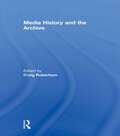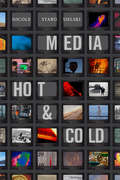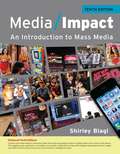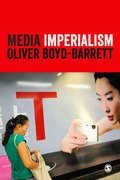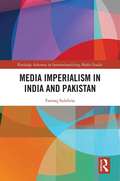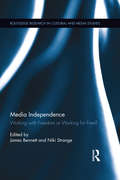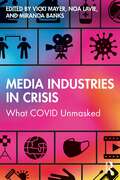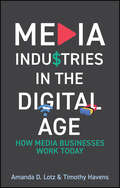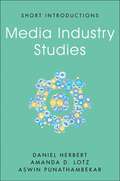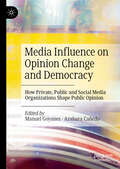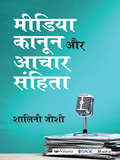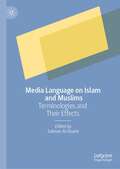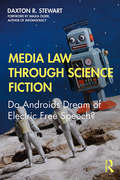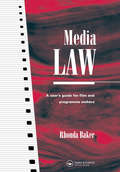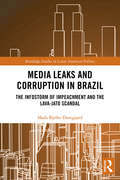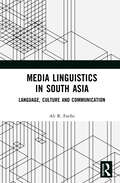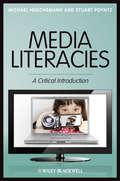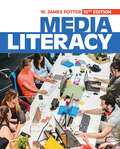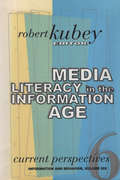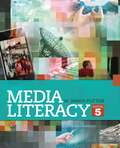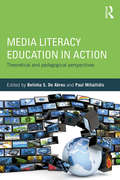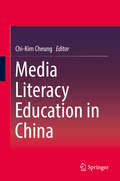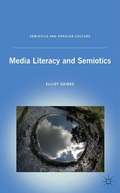- Table View
- List View
Media Heterotopias: Digital Effects and Material Labor in Global Film Production
by Hye Jean ChungIn Media Heterotopias Hye Jean Chung challenges the widespread tendency among audiences and critics to disregard the material conditions of digital film production. Drawing on interviews with directors, producers, special effects supervisors, and other film industry workers, Chung traces how the rhetorical and visual emphasis on seamlessness masks the social, political, and economic realities of global filmmaking and digital labor. In films such as Avatar (2009), Interstellar (2014), and The Host (2006)—which combine live action footage with CGI to create new hybrid environments—filmmaking techniques and "seamless" digital effects allow the globally dispersed labor involved to go unnoticed by audiences. Chung adapts Foucault's notion of heterotopic spaces to foreground this labor and to theorize cinematic space as a textured, multilayered assemblage in which filmmaking occurs in transnational collaborations that depend upon the global movement of bodies, resources, images, and commodities. Acknowledging cinema's increasingly digitized and globalized workflow, Chung reconnects digitally constructed and composited imagery with the reality of production spaces and laboring bodies to highlight the political, social, ethical, and aesthetic stakes in recognizing the materiality of collaborative filmmaking.
Media History and the Archive
by Craig RobertsonBy the time readers encounter academic history in the form of books and articles, all that tends to be left of an author’s direct experience with archives is pages of endnotes. Whether intentionally or not, archives have until recently been largely thought of as discrete collections of documents, perhaps not neutral but rarely considered to be historical actors.This book brings together top media scholars to rethink the role of the archive and historical record from the perspective of writing media history. Exploring the concept of the archive forces a reconsideration of what counts as historical evidence. In this analysis the archive becomes a concept that allows the authors to think about the acts of classifying, collecting, storing, and interpreting the sources used in historical research. The essays included in this volume, from Susan Douglas, Lisa Gitelman, John Nerone, Jeremy Packer, Paddy Scannell, Lynn Spigel, and Jonathan Sterne, focus on both the theoretical and practical ways in which the archive has affected how media is thought about as an object for historical analysis.This book was published as a special issue of The Communication Review.
Media Hot and Cold (Elements)
by Nicole StarosielskiIn Media Hot and Cold Nicole Starosielski examines the cultural dimensions of temperature to theorize the ways heat and cold can be used as a means of communication, subjugation, and control. Diving into the history of thermal media, from infrared cameras to thermostats to torture sweatboxes, Starosielski explores the many meanings and messages of temperature. During the twentieth century, heat and cold were broadcast through mass thermal media. Today, digital thermal media such as bodily air conditioners offer personalized forms of thermal communication and comfort. Although these new media promise to help mitigate the uneven effects of climate change, Starosielski shows how they can operate as a form of biopower by determining who has the ability to control their own thermal environment. In this way, thermal media can enact thermal violence in ways that reinforce racialized, colonial, gendered, and sexualized hierarchies. By outlining how the control of temperature reveals power relations, Starosielski offers a framework to better understand the dramatic transformations of hot and cold media in the twenty-first century.
Media Impact: An Introduction to Mass Media (10th Edition)
by Shirley BiagiFrom media history to today's rapid-fire changes, MEDIA/IMPACT takes you on a tour of the events, people, and technologies that have shaped and are shaping the industry. Known for its engaging writing style, currency, and visual appeal, this book explores the converged mass media--its industries and support industries as well as the legal, ethical, social, global, and technological issues these businesses face very day. Emphasizing the impact of the media on individuals and society, the book illustrates that the media are foremost in the business of making money and shows you students what it's like to work in each industry. Included are detailed timelines and an extensive online media careers guide.
Media Imperialism
by Dr Oliver Boyd-BarrettHow does control of media resources serve political and economic ends? What is the impact of media concentration and monopoly in the era of technology convergence, with not just traditional and 'new' media but also consumer electronics, telephony and computing industries? Revisiting the classic concept of media imperialism, Oliver Boyd-Barrett presents a thorough retake for the 21st century, arguing for the need to understand media and empires and how structures of power and control continue to regulate our access to and consumption of the media. It's no longer just Disney and Dallas - it's also now Alibaba, Apple, Facebook, Google, Samsung and Huawei. Examining the interplay between communications industries and the hierarchies and networks of political, corporate and plutocratic power in a globalized world, the book explains: ? the historical context of the relationship between media and imperialism; contestation and collaboration among new media empires; the passion for social justice that inspired the original theories of media and cultural imperialism, and how it has been embraced by a new generation. Digging deeply into the global landscape and emerging media markets to explore how media power works across transnational boundaries, this book gives a clear and sophisticated argument for why media imperialism still matters.
Media Imperialism in India and Pakistan (Routledge Advances in Internationalizing Media Studies)
by Farooq SulehriaExamining anew the notions of media imperialism and globalization of media, this book disrupts the generalised consensus in media scholarship that globalization of media has put an end to media imperialism. One elemental aspect of media imperialism is the structural dependency of television systems in the global South on the imperial North. Taking India and Pakistan as its case studies, this book views globalization of media as the unleashing of processes that have translated into the liberalization of air waves and privatization of television systems whereby commercialization of television is privileged over public interest television. Additionally, it argues that the globalization of media has contributed to corruption, tabloidization, and marginalization of subaltern classes in the Indian and Pakistani media.
Media Independence: Working with Freedom or Working for Free? (Routledge Research in Cultural and Media Studies)
by James Bennett Niki StrangeMedia independence is central to the organization, make-up, working practices and output of media systems across the globe. Often stemming from western notions of individual and political freedoms, independence has informed the development of media across a range of platforms: from the freedom of the press as the "fourth estate" and the rise of Hollywood’s Independent studios and Independent television in Britain, through to the importance of "Indy" labels in music and gaming and the increasing importance of independence of voice in citizen journalism. Media independence for many, therefore, has come to mean working with freedom: from state control or interference, from monopoly, from market forces, as well as freedom to report, comment, create and document without fear of persecution. However, far from a stable concept that informs all media systems, the notion of media independence has long been contested, forming a crucial tension point in the regulation, shape, size and role of the media around the globe. Contributors including David Hesmondhalgh, Gholam Khiabany, José van Dijck, Hector Postigo, Anthony Fung, Stuart Allan and Geoff King demonstrate how the notion of independence has remained paramount, but contested, in ideals of what the media is for, how it should be regulated, what it should produce and what working within it should be like. They address questions of economics, labor relations, production cultures, ideologies and social functions.
Media Industries in Crisis: What COVID Unmasked
by Vicki MayerThis edited volume offers a global overview of the immediate impacts the COVID pandemic had on local and national film, television, streaming, and social media industries—examining in compelling detail how these industries managed the crisis.With accounts from the frontlines, Media Industries in Crisis provides readers with a stakeholder framework, management lessons, and urgent commentaries to unpack the nature of crisis management and communications. The authors show how these industries have not only survived, but often thrive amidst a backdrop of critical national and regional emergencies, wars, financial meltdowns, and climate disasters. This international collection—featuring case studies from 16 countries—examines how media industries managed all of these crises, successfully rebranding themselves as “essential” while making power plays in politics, economics, and culture. The chapters reveal key lessons for the meltdowns, tectonic shifts, and struggles ahead.This collection will be of interest to media and communication students, particularly those focused on media industries, crisis communications, and management, as well as to practitioners working in media industries.
Media Industries in the Digital Age: How Media Businesses Work Today
by Amanda D. Lotz Timothy HavensThe digital communication technologies that emerged at the turn of the century have profoundly disrupted long-practiced norms of nearly every media industry. In particular, internet distribution has fundamentally changed the foundation of the media industry to enable the emergence of new sectors while posing a challenge for others. Media Industries in the Digital Age reframes our understanding of media businesses in the light of these substantial changes. To develop an integrated understanding of media industries today, the book foregrounds the different funding sources that are now common. It begins by mapping the foundations and developments of media industry operation, and exploring all forms of advertiser-funded and consumer-funded media to identify connections across sectors, including digital and legacy media. The final section grounds the book’s conceptual work in examples of media making to explore how some “old” media have successfully adapted to internet disruption, and the differences and similarities of media making outside of corporations. Looking to the future, the book anticipates implications for the emerging “metaverse” media experiences and the key issues generative AI poses to the sector. Ultimately, the book argues that the contemporary differences in media industry operation vary by sector, but meaningful patterns can be identified by considering how advertiser, consumer, or government funding sets different priorities.Offering a new and original way of understanding the media industries today, this book is enlightening reading for students and scholars of media studies and media industries, as well as global industry professionals
Media Industry Studies (Short Introductions)
by Daniel Herbert Aswin Punathambekar Amanda D. LotzThe study of media industries has become a thriving subfield of media studies. It already comprises a diverse intellectual history, a range of fascinating questions and topics, and many theoretical and methodological frameworks.Media Industry Studies provides the roadmap to this vibrant area of study. Blending a comprehensive overview of foundational literature with an examination of the varied scales and sites media industry studies have considered, the book explores connections among research questions, topics, and methodologies. It includes examples from many media industries – film, television, journalism, music, games – and incorporates emerging scholarship considering the industrial contexts of social and internet-distributed media.Offering an account of the intellectual traditions and approaches that have defined the subfield to date, Media Industry Studies is an indispensable resource for upper-level undergraduates, postgraduates, and scholars.
Media Influence on Opinion Change and Democracy: How Private, Public and Social Media Organizations Shape Public Opinion
by Manuel Goyanes Azahara CañedoThis book reviews and advances the theoretical and empirical knowledge at the intersection of opinion change and democracy. Specifically, the volume addresses how opinion change and political persuasion unfold in three main domains of media effects: private media (i.e., news organizations), public service media (state-own media services), and social media platforms. Divided in these three different sections, the volume serves as a venue to discuss and further advance the most recent theoretical assumptions and empirical findings that underpin our current understanding on how media influence public opinion and shape liberal democracies. The book also explores how media literacy and critical thinking can mitigate the effects of misinformation and propaganda, emphasizing the importance of educating the public to discern credible information from deceptive content. Furthermore, it discusses the ethical implications of media practices and the responsibilities of media producers in maintaining the integrity of democratic discourse. By highlighting these aspects, the book provides a comprehensive understanding of the complex interplay between media, public opinion, and democracy, offering valuable insights for scholars, policymakers, and anyone interested in the role of media in shaping public opinion.
Media Kanoon aur Aachaar Sanhita
by Shalini JoshiCitizens’ rights and institutional autonomy are dependent on ethical journalism, but corporatisation, market controls, political pressures and favouritism have made it difficult for media professionals to follow ethical standards and practice socially responsible journalism. This is a reference book for academics working in media studies, media professionals and students of journalism and mass communication. It is also meant for people in positions of authority in media organisations, for whom an understanding of ethical guidelines and duties of the media as well as legal limitations are of vital importance. This book will be of help both to academics and students and to journalists who face ethical dilemmas and experience the many challenges to fearless journalism.
Media Language on Islam and Muslims: Terminologies and Their Effects
by Salman Al-AzamiThis book brings together contributions from ten academics and a commentary from a Muslim community leader on how the British media represent some of the most important terminologies related to Islam and Muslims. It takes a nuanced approach to language within Muslims in the media research by focusing on terminologies. Each contributor in this volume focused on one terminology and its associated words to show how the representation of these terminologies have major implications on the lives of British Muslims. The book also includes some key recommendations on the usage of these terms from the Media Style Guide of the Centre for Media monitoring - a research organisation of the Muslim Council of Britain. This book’s link with the Muslim community can be a step towards new approaches in this field where academics will engage with communities and practitioners to ensure better impact of their academic works. This book will be of interest to students, scholars and practitioners in a range of fields, including Journalism, Media and Communication Studies, English Language and Linguistics, Sociology, Cultural and Religious Studies.
Media Law Through Science Fiction: Do Androids Dream of Electric Free Speech?
by Daxton R. StewartAttorney and legal scholar Daxton Stewart examines the intersection of media law and science fiction, exploring the past, present, and future of communication technology and policy debates. Science fiction offers a vast array of possibilities anticipating future communication technologies and their implications on human affairs. In this book, Stewart looks at potential legal challenges presented by plausible communication technologies that may arise 20 or 50 or 100 years from today. Performing what he calls "speculative legal research," Stewart identifies the kinds of topics we should be talking about relating to speech, privacy, surveillance, and more, and considers the debates that would be likely to arise if such technologies become a reality. Featuring interviews with prominent science fiction authors and legal scholars, and a foreword by Malka Older, this book considers the speculative solutions of science fiction and their implications in law and policy scholarship. Chapters feature specific literary examples to examine how cultural awareness and policy creation are informed by fictional technology, future societies, and legal disputes. Looking forward, beyond traditional legal research and scholarship to the possible and even very likely future of communication technology, this fascinating work of speculative legal research will give students and scholars of media law, science fiction, and technology much to discuss and debate.
Media Law: A User's Guide for Film and Programme Makers
by Rhonda BakerFirst Published in 1994. Routledge is an imprint of Taylor & Francis, an informa company.
Media Leaks and Corruption in Brazil: The Infostorm of Impeachment and the Lava-Jato Scandal (Routledge Studies in Latin American Politics)
by Mads Bjelke DamgaardAnalyzing the political consequences of the most extensive corruption investigation in recent Latin American history, Operação Lava-Jato, Media Leaks and Corruption in Brazil answers two central questions about the contradictory effects news media has on political systems. First, how can political actors in a seemingly well-functioning democracy quickly override checks and balances, and replace a head of state with a corrupt vice-president? Second, how can very active news media, while ostensibly performing the role of the watchdog, still fail to deliver media accountability to the public? Combining a quantitative view of the media sphere with case studies of the leaks, legal actions, and alliances forming and breaking in the Brazilian Congress, Mads Bjelke Damgaard demonstrates that the media’s attention to leaks and investigations of corruption paved the way for Dilma Rousseff’s impeachment. By timing the disclosure of information in scandals, actors with inside information were able to drive the media agenda and let some scandals escape from the limelight. The book delivers an in-depth study of how scandals become political weapons in a time of media personalities and post-politics. This book will interest scholars of Latin American Studies, and Brazil, and the broader fields of media studies, democracy studies, and journalism studies.
Media Linguistics in South Asia: Language, Culture and Communication
by Ali R FatihiThe tone and texture of the language of media have changed considerably due to the rapid expansion of media in recent times and advancements in communication technologies. This book examines new ways to conduct linguistic explorations into the myriad of forms news is being presented and consumed. The volume contributes to the emerging field of media linguistics by measuring and analysing the associations between linguistics and the news discourse. It extends the conceptualization of language-media relations in sociolinguistics beyond the notions of ‘influence’ and ‘effect’ and broadens the theoretical and empirical scope of the discipline. The author discusses different perspectives of media linguistics; issues of variation in language of media; question of plurilingual resources; parallel language use in media and textuality of news genres. He further analyses the dynamics of news reportage by studying the coverage of conflicts, violence and dissent in South Asian media in recent decades along with the reportage of cricket headlines and news. Comprehensive and topical this volume will be useful for scholars and researchers of linguistics, media linguistics, applied linguistics, media studies, media sociology, sociology, cultural studies and South Asian studies.
Media Literacies: A Critical Introduction (Critical Media Literacies Ser. #1)
by Michael Hoechsmann Stuart R. PoyntzMedia Literacies: A Critical Introduction traces the history of media literacy and grapples with the fresh challenges posed by the convergent media of the 21st century. The book provides a much-needed guide to what it means to be literate in today’s media-saturated environment. Updates traditional models of media literacy by examining how digital media is utilized in today’s convergent culture Explores the history and emergence of media education, the digitally mediated lives of today’s youth, digital literacy, and critical citizenship Complete with sidebar commentary written by leading media researchers and educators spotlighting new research in the field and an annotated bibliography of key texts and resources
Media Literacy
by W. James PotterMedia Literacy teaches students how to navigate through the overwhelming flood of information found in today’s media-saturated world. Drawing from thousands of media research studies, author W. James Potter explores key components to understanding the fascinating world of mass media. Potter presents examples and facts to help students understand how the media operate, how they attract attention, and how they influence the public. Chapters conclude with exercises to help readers apply the material to everyday life and improve their media literacy. The Tenth Edition integrates a stronger focus on digital media, features a streamlined organization, and updates facts to keep readers informed on the rapidly changing media phenomenon.
Media Literacy
by W. James PotterMedia Literacy teaches students how to navigate through the overwhelming flood of information found in today’s media-saturated world. Drawing from thousands of media research studies, author W. James Potter explores key components to understanding the fascinating world of mass media. Potter presents examples and facts to help students understand how the media operate, how they attract attention, and how they influence the public. Chapters conclude with exercises to help readers apply the material to everyday life and improve their media literacy. The Tenth Edition integrates a stronger focus on digital media, features a streamlined organization, and updates facts to keep readers informed on the rapidly changing media phenomenon.
Media Literacy Around the World (Information and Behavior Series)
by Robert KubeyAt the dawn of the twenty-first century, education about and through the media has become a worldwide phenomenon, and is playing an increasingly important role in educational reform. The theory and practice of media education have profited greatly from recent and intensive development and application of new information and telecommunications technologies. Consequently, the importance of media and information literacy is taking on an even greater urgency. With this in mind, the contributors to this volume survey what has taken place over the last decade in different parts of the world, examine the current state of theoretical, conceptual, and research development, and consider where media education is going and where it ought to go. With two-thirds of its 22 contributions coming from outside the United States, Media Literacy around the World is a genuine international effort, with many leading media and information educators in the world taking part. The work converts the notion of globalism from a slogan into a working hypothesis. The concerns in this volume are with literacy not just in computer technology, but as a broad concern of the educational process.
Media Literacy Edition 5
by W. James PotterThis is a textbook on media: where it reaches and why, who generates it, where its growth has taken us and its further pathways into our lives. The point is that it's a media-saturated world and that acquiring media literacy is possible, and also critical to both fending off the negative or even destructive consequences of media and finding the potential benefits of it. Organization of the text is around these major areas, with very detailed investigation within these: introductory definitions and discussion of the media literacy approach; audience; industry; content; effects; confronting the issues; personal strategy for increasing media literacy and helping others to do the same. Potter (media studies, University of California, Santa Barbara) has added new material on social media sites.
Media Literacy Education in Action: Theoretical and Pedagogical Perspectives
by Paul Mihailidis Belinha S. De AbreuMedia Literacy Education in Action brings together the field’s leading scholars and advocates to present a snapshot of the theoretical and conceptual development of media literacy education—what has influenced it, current trends, and ideas about its future. Featuring a mix of perspectives, it explores the divergent ways in which media literacy is connected to educational communities and academic areas in both local and global contexts. The volume is structured around seven themes: • Media Literacy: Past and Present • Digital Media and Learning • Global Perspectives • Public Spaces • Civic Activism • Policy and Digital Citizenship • Future Connections Compelling, well-organized, and authoritative, this one-stop resource for understanding more about media literacy education across disciplines, cultures, and divides offers the fresh outlook that is needed at this point in time. Globally, as more and more states and countries call for media literacy education more explicitly in their curriculum guidelines, educators are being required to teach media literacy in both elementary and secondary education contexts.
Media Literacy Education in China
by Chi-Kim CheungThe Chinese government has long kept tight control on both traditional and new media to prevent potential challenges to its authority. But, for better or worse, China has now reached a stage where it is difficult to exercise political hegemony through laws and regulations and the control of the mass media. China has become a global superpower and in 2011 surpassed Japan as the world's second largest economy, second only to the USA. China's entertainment industry is also flourishing, and the market is large enough to attract foreign investors that either view China as an important market or are interested in Chinese capital. Today, more children in China watch television than in any other country in the world, and Internet usage is also increasing, making the implementation of media literacy education an important issue. This book presents the prevailing perspectives on media literacy education in China and describes how the current curriculum reform for implementing media literacy education is being developed. It will not only stimulate debate and further research, but will also influence policy decisions regarding media literacy education in China.
Media Literacy and Semiotics
by Elliot GainesMedia Literacy and Semiotics provides helpful tools to help readers think critically about the meaning of the media images they are exposed to on a daily basis. In this comprehensive book, a basic model of semiotic logic is applied to a variety of media studies to promote critical thinking and media literacy. Elliot Gaines systematically analyzes the hidden meanings in mass-mediated products and texts, and shows how basic meaning structures underlie everything from The Daily Show to television documentaries to infotainment.

